Readers may remember that some time ago I wrote about the National Ideological Resistance (aka Imam al-Mahdi Army), a Syrian Hezbollah-brand group with its primary base and origins in the Tartous-Masyaf area and led by Sayyid Hashim Muhammad Ali. The National Ideological Resistance has fought in a variety of areas (including Damascus, Palmyra and Aleppo) and has claimed dozens of 'martyrs'. It has also proclaimed the establishment of affiliates in the northeast of Syria and Quneitra.
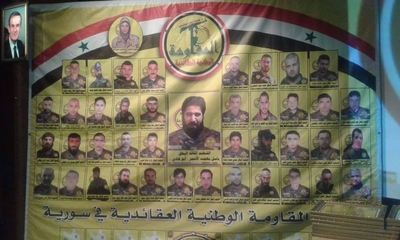 Poster of 'martyrs' of the National Ideological Resistance. |
What has become of the group today? What is its status in the wider milieu? The National Ideological Resistance still exists on the ground, but despite its Syrian Hezbollah image, the organization officially asserts that it is independent. As Sayyid Hashim put it to me in a statement recently:
"It [the National Ideological Resistance] is not affiliated with any side, but it works with all sides and on all fronts without a direct affiliation. We do not have an affiliation with the [Iranian] Revolutionary Guard or Hezbollah. We are from all components of the Syrian people and throughout the lands of the Syrian Arab Republic, but we work with all national sides and those of friends."
For the reader's understanding: the جهات صديقة he speaks of normally refers to foreign allies of the Syrian government.
The statement contrasts with many other groups that also have a Syrian Hezbollah image but actually profess affiliation with Hezbollah/Iran's Islamic Revolutionary Guard Corps (IRGC). Many of these groups, rather than being isolated local entities, have become integrated into the Local Defence Forces (LDF) structure, which is backed by Iran and has an affiliation with the IRGC but at the same time is also on the registers of the Syrian armed forces.
However, while the National Ideological Resistance is officially professed to be independent as an organization, it must be noted that fighting contingents that have existed under its wing have an affiliation with the LDF. The most notable case is that of al-Khal ('The Uncle'), who is originally from Tartous and is involved with the National Ideological Resistance. A page entitled "Local Defence Forces: Tartous sector" has featured photos of the "al-Khal contingents" stationed in Aleppo province, in particular the Afrin area. These contingents are sometimes described as "border guard" forces: that is, apparently acting as border guards between the government-held areas and the Kurdish-led Syrian Democratic Forces/YPG in the Afrin area. These contingents led by al-Khal have been linked with Fawj al-Nayrab of the Aleppo LDF.
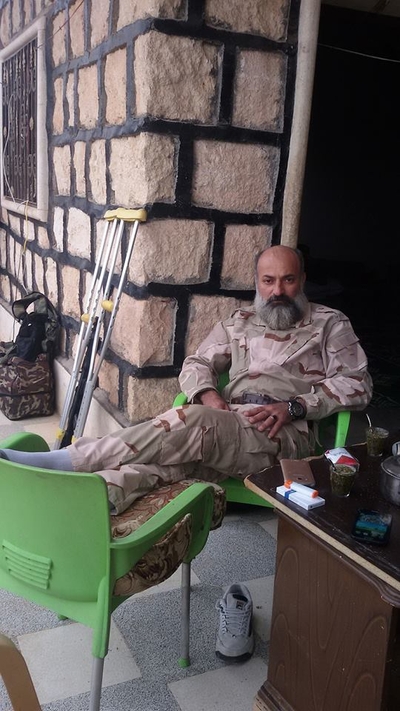 al-Khal |
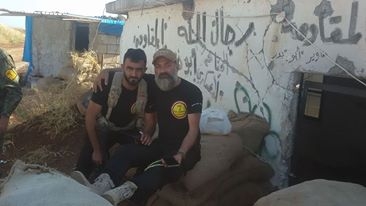 On right: al-Khal. Note the shirt he is wearing with the National Ideological Resistance logo on it. |
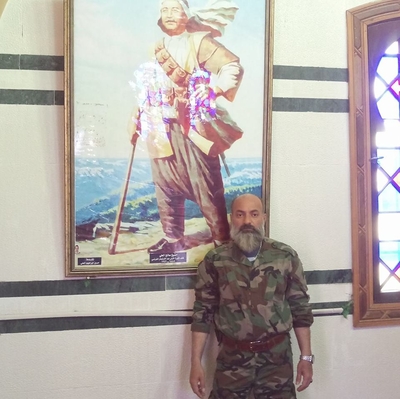 al-Khal in front of a portrait of Saleh al-Ali, an Alawite who led a revolt against the French in 1919. |
As al-Khal himself explained to me regarding his relationship with Sayyid Hashim and the LDF: "We [Sayyid Hashim and I] are with each other, but I have taken forces from the [National Ideological] Resistance and affiliated them with the Local Defence." He explained that he joined the LDF around 8 months ago, which would correspond to April/May 2017. In April 2017, the LDF received recognition from the Syrian government. That is, those within the LDF who had evaded obligatory service, reserve service and deserted the army would have their status regularized and the summoning status for obligatory/reserve service altered to the LDF, whereas civilians working with the LDF could have recruitment contracts of two years subject to extension within the 'People's Army' (al-Jaysh al-Sha'abi). Regarding the LDF sector affiliation of his contingents, al-Khal explained it as follows: "I am the recipient of personnel in Tartous who are working in Aleppo."* As with other LDF contingents, operations are not necessarily confined to the sector/area of origin.
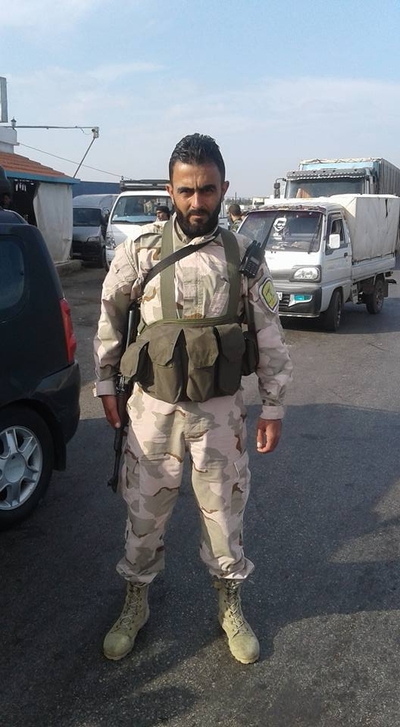 Among the photos put out by the LDF Tartous page: note the National Ideological Resistance armpatch. |
In short, this case continues the trend of integrating forces into larger networks and highlights the importance of not simply counting groups as individual entities for the sake of producing simplistic statistics.
-----------------------
*- It will be noted from the LDF administrative decisions in April 2017 that relatively few personnel are recorded under the Tartous sector in comparison with sectors like Aleppo and Damascus.

